The Stephen Petronio Company revives works by those who have influenced him and offers a world premiere.
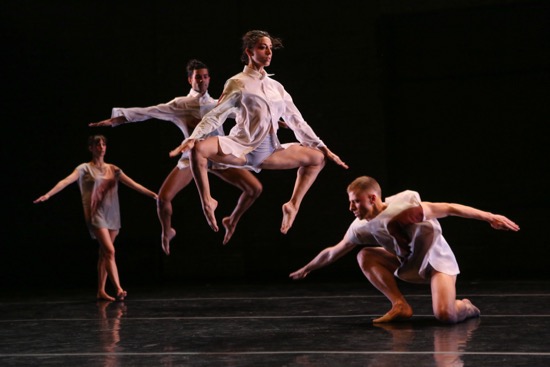
Stephen Petronio’s new Untitled Touch. (L-R) Tess Montoya, Ernesto Breton, Jaqlin Medlock, and Nicholas Sciscione. Photo: Julie Lemberger
Once upon a time, a choreographer of “modern dance” was expected to create his/her unique style—a difficult task, since human bodies are the material, and human bodies inevitably become imprinted with their histories. I think I would know a dance by Stephen Petronio if I met it in a dark alley, but he is not hiding the fact that others have influenced him. Since he established “Bloodlines” in 2014, his eight-person ensemble has performed Merce Cunningham’s RainForest and Trisha Brown’s Glacial Decoy. His five-year project is as fruitful as it is honorable, in that it challenges his dancers and gives him a little respite from being the Stephen Petronio Company’s sole choreographer.
This season, he delved further, presenting his dancers at the Joyce Theater in three 1960s pieces by Yvonne Rainer, an excerpt from a 1986 one by Steve Paxton (with whom Petronio worked early on), and a solo that Anna Halprin made for herself in 1999. Brown, in whose company Petronio performed for seven years, had, along with Rainer and Steve Paxton (formerly a member of Cunningham’s company), been bedrock contributors to Judson Dance Theater, New York’s influential and iconoclastic 1960s group. And in the late 1950s, Brown and Rainer spent a summer studying with Halprin in her studio on Mount Tamalpais in California’s Marin County.
The bloodlines running through these works aren’t perpetuating copycat styles; aside from occasional details, they bear larger ideas about space and time. When Halprin once asked her students to compose a dance triggered by the verbs “sit,” “lie,” and “stand,” she can’t have expected that Brown would try lying down several feet off the ground.
The program at the Joyce is also a reminder that reconstructions are a bit like postcards of a fine view, as opposed to the photo you snapped yourself from the same spot, whipped by wind and a bit woozy from the wine you drank at lunch. Yet, faithfully preserved, they’re illuminating.
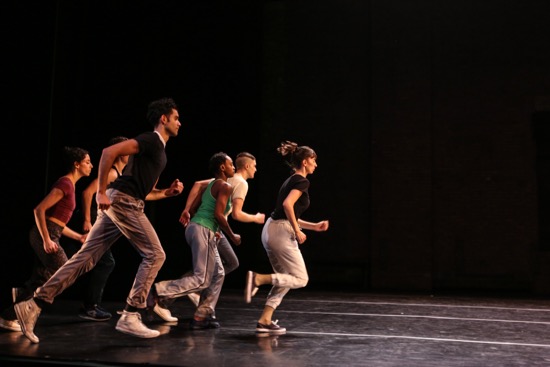
Yvonne Rainer’s Diagonal. (L-R) Jaqlin Medlock, Kyle Filley, Ernesto Breton, Davalois Fearon, Joshua Tuason, and Tess Montoya. Photo: Julie Lemberger
The three Rainer works were coached by Pat Catterson, who has worked extensively with the choreographer. I had never seen the 1963 Terrain and found an excerpt from it, “Diagonals” absorbing—as did most of the spectators at the Joyce Theater. Its structure (influenced perhaps by Cunningham) is indeterminate. This means that the six dancers who perform it (Ernesto Breton, Davalois Fearon, Kyle Filley, Jaqlin Medlock, Tess Montoya, and Megan Wright) have learned ten phrases of movement that travel along one or the other of the stage’s diagonals, plus four that are performed by only one or two people (and contain sub-choices as well). The numbers and/or letters associated with these elements are called out by someone in the group. Several additional rules influence joining and separating.
To perform Diagonal, these highly trained dancers have to identify themselves as smart, relaxed, athletic people performing a complex game (no laughing allowed). The movements aren’t entirely pedestrian; some involve tricky hand-foot coordination or dance knowledge (for instance, “7” means that two people pick up a third under the arms and carry him/her along a diagonal, while the others follow along). Some possibilities are whimsical: march on tiptoe with cheeks puffed out, walk bent-kneed and twisted front with fingers in ears and elbows horizontal. Others are springy. At times, clustered in corners, the dancers “mill,” lifting their knees high and placing their feet carefully. Watching Diagonal is like watching a game whose rules you don’t know, but want to fathom. Now all six travel one of the diagonals, doing the same things. Now they’ve broken into two squads, moving contrapuntally. Now someone is marooned alone, but is subsequently absorbed by a moving group. You get pleased with yourself when you hear a number or letter called out and know what will ensue. Process becomes part of the product.
Rainer’s Trio A (1966) is a long chain of movements, performed in a kind of physical monotone, giving no one of them more emphasis than the others. A movement may be performed a few times in a row, but not re-introduced later. These elements are elegantly, imaginatively created, contrasting in shape, scale, and direction in space.

The Stephen Petronio Company’s Joshua Tuason (L), Megan Wright and Nicholas Sciscione perform Yvonne Rainer’s Trio A With Flags. Photo: Julie Lemberger
The original trio acquired many versions, and for a while, Rainer let anyone perform it who wanted to do so, until, she said, she met a Trio A she didn’t like. Sciscione, Tuason, and Wright first perform the iconic dance as it was presented in Judson Church in 1970 as part of the “People’s Flag Show,” a protest against the arrest of a gallery owner who had presented an exhibit in which the American flag was used in ways that linked obscenity with the the escalating war in Vietnam. The three undress on stage behind five-foot flags that are tied about each one’s neck like a bib and execute the dance naked except for that red, white, and blue rectangle. The act was conceived in defiance; the nakedness also conveys vulnerability. In 1970, the dancers tried to keep the flags from touching the floor, perhaps protecting themselves from censorship, or worse—an action must have lent additional irony to the performance. You probably don’t need me to mention the dance’s relevance to today’s political chaos—labeled in the program as “a tactical act of resistance.”
Since we may have focused a bit too much on the flags and the nudity, the group then gravely performs Trio A in simple, sporty outfits, alongside a recording of the Chambers Brothers singing their rollicking love song “In the Midnight Hour.” Each person performs pretty much at his/her preferred pace, so the image of individuality within unison makes another kind of statement.
Chair-Pillow was a section of Rainer’s 1969 Continuous Project-Altered Daily. I saw the version staged at the Whitney Museum, where, as I recall, other events penetrated it. This version is a scaled-down take on the one presented by Rainer at Dia Beacon in 2012. To the sounds of Ike and Tina Turner singing “River Deep Mountain High,” the company members walk on carrying folding chairs and pillows, set themselves up facing the audience, and perform, over and over, a short phrase on or beside the chair; this involves doing, with the utmost efficiency, things that pillows and chairs are good for. Either the performers are choosing their own timing, or it has been set. For instance, Montoya sits for quite a while with the pillow on her lap, waiting her turn to begin. Your eye travels around the stage, caught by a decisive change here, a simmering down there. To end it, Petronio walks in with chair and pillow and settles down.
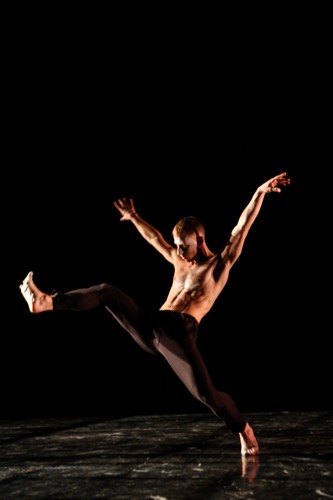
Nicholas Sciscione performing an excerpt from Steve Paxton’s Goldberg Variations. Photo: Julie Lemberger
Joe Doran’s lighting for the Rainer works is suitably simple. Ken Tabchnick’s lighting provides a touch of drama to Sciscione’s performance of an excerpt from Paxton’s Goldberg Variations. Glenn Gould made two recordings of Bach’s music—one in 1992, the other in 1955. The sections to which Sciscione dances (16-23) are set to the earlier of the two (the one in which you don’t hear Gould humming along). Paxton danced to both Gould recordings in each of his performances over a period of six years (1986-1992)— improvising, altering, resting if he needed to. Seeing him do this was one of the best experiences of my viewing life. A skilled dancer, Paxton also looked a rough-edged, at times a bit don’t-care, at times tiring, but malleable, nuanced, sensitive. He stopped, staggered, reeled, became precise. It’s as if he were dancing in a dream, the music playing him.
I couldn’t expect Sciscione to channel Paxton. He may have learned the dance from a video and experimented with it. A marvelous dancer, he emphasizes the sinuous qualities of some of the movements, getting a current running through his body. Along with everyone else, I applauded his subdued virtuosity, his thoughtfulness, his endurance. And I honor the Petronio’s desire to acknowledge the aspects of sensitivity and malleability that may have threaded their way from Paxton into his own choreography.
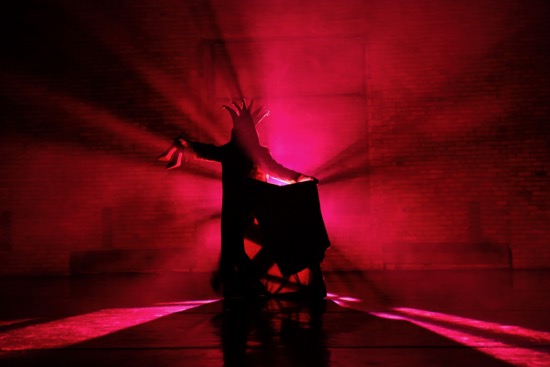
Stephen Petronio in Anna Halprin’s The Courtesan and the Crone. Photo: Julie Lemberger
Anna Halprin chose not to give one of her influential early works to Petronio. She created the brief vignette titled The Courtesan and the Crone for herself when she was 79 and, now 97, coached him in it. Petronio, barely past 50, but wanting to be in touch with his roots, accepted the role. The solo suggests that Halprin, a feminist, was slow to accept the sneaking away of sexuality that dismays many aging women, and was making fun of herself at the same time.
A figure emerges into view from the back of a stage lit fiery red. It takes a few moments to realize that it has its back to us, as it moves toward the front of the stage. A gold brocade robe, a mass of black hair, a headdress. Then it turns to face us. Ah, a woman. A woman with a blandly pretty white mask, a woman wearing gloves. She blows a reticent kiss to the audience, subtly hitches up a breast, opens her robe to display a shapely leg. After a few minutes of charming us, she slowly unbuttons the coat and turns away to peel away more layers: the headdress, the wig (but not the mask). As Doran pins her in relentless yellow light, she turns to us again, touches her crotch, suffers, calms herself, and slowly backs away as the lights turn white and then go out. Seeing this embodied by Petronio inevitably links it to drag performance, but its humor is countered by a kind of fragility and the stripping away of disguise.
We saw all these works except The Courtesan and the Crone before the intermission and without pauses. I didn’t use that intermission to read the program note for Petronio’s new work, Untitled Touch. Absorbed in taking it in, I didn’t try to identify what he calls “clear nods to Trisha Brown’s dynamism, Paxton’s athleticism, Rainer’s intellect, and Halprin’s humanity.”
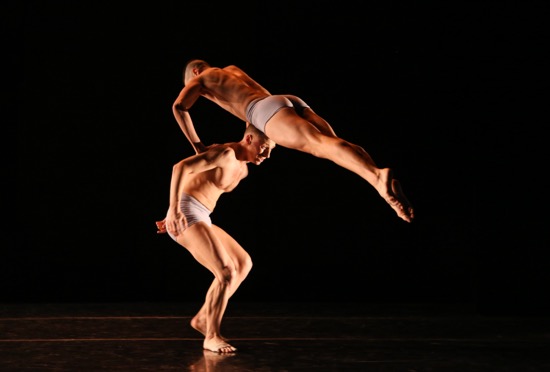
Joshua Tuason and (in air) Nicholas Sciscione in Stephen Petronio’s Untitled Touch. Photo: Julie Lemberger
Untitled Touch, as he also said, has its own logic. It made me ponder all the ways in which we touch one another, or don’t. The costumes by H. Petal and Naomi Luppescu reinforce this notion. The white expanse of the dancers’ shirts bear different images—a large hand attached to part of an arm, for example, or two hands clasped; on one shirt, a hand reaches around from the back until it’s just over the wearer’s breast. The score by Petronio’s frequent collaborator Son Lux begins with the sound of a piano crashing, then subsiding into a quiet flurry. The music throughout is ongoing, driving. The dance rides it or punctuates it.
At the outset, Ken Tabachnick’s lighting pins Montoya and Filley in one spot. They are tracing each other’s bodies, the hand doing the outlining held a few inches away from the surface it is investigating. They are also formal, slightly stiff in the way they present a limb, as if trying to be very clear in this intimate “conversation” they’re having. They’re succeeded by Sciscione and Tuason in a bolder encounter that takes up more space. At one point Tuason crouches down and Sciscione squats on his back; later, Scisione rubs his head along Tuason’s outstretched arm. They separate, then reconnect. And that seems to be a theme. The eight dancers come and go, meet, join together, exchange information, part, and fall into new encounters, new joint projects. Many of these are vibrantly physical; the dancers launch themselves into the air, twist against unseen forces, wheel and slash their limbs—straight from shoulder to fingertips and from hips to toes—like propellers rioting.
The dancers aren’t not always fettered by gender; Tuason strikes a balance, and Fearon promenades him into a turn. For a while, three pairs dance in unison. Often some of the people onstage wait, posed, watching their colleagues in what seems to be a changeable climate. You see images of combat or erotic encounters like one Fearon and Sciscione fall into. You see dancers’ arms semaphoring in no language you know. Fearon alone dances fiercely. People hold onto one another to form tangled lines and clusters. Occasionally, an odd incident catches your eye; while Tuason, in a collaborating group, is leaning over, Montoya reaches out with one hand and mimes screwing something into his back.
The last moments of Untitled Touch involve the most intense forms of touch, and for this duet, Sciscione and Tuason strip down to gray trunks. They bring their bodies together in intricate consensual ways, but these are athletes. One man may out a hand to receive his companion’s head. One may brace himself to enable the other to vault into the air. The duet is intimate, yet somehow not overtly erotic; the two perform it as if it were a complex game whose rules they are sensing along the way.
If Halprin, Rainer, Paxton, and Brown’s spirit were looking at this dance, it’s moot whether they would detect their influences on Petronio. Their touches are light, but nonetheless layered deep down in his creative soul.
